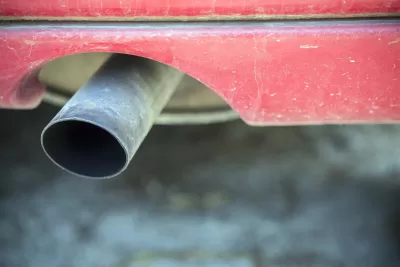Emissions prevented by new tailpipe standards announced by the Biden administration in December 2021 will be measured in the billions.

The news broke that the U.S. Environmental Protection Agency had finalized new greenhouse gas emission standards for passenger car and light trucks on December 20, reversing standards imposed by the previous Trump administration and resetting to emissions standards put into place by the Obama administration.
Planetizen picked up the news at the time, focusing on the new standards (i.e., cars, SUVs, and pickup trucks must release an average of 161 grams of carbon dioxide per mile by 2026) and provided a brief recap of how the emissions standards administrations have seesawed between recent administrations, but another article by Emily Pontecorvo for Grist focuses on the environmental consequences of the new standards. Here, Pontecorvo summarizes the new rule at length:
The agency says the new standards will prevent 3 billion tons of carbon dioxide from entering the atmosphere over the next 30 years and will reduce gasoline consumption by 360 billion gallons. By reducing the amount of fuel burned, the standards will also lower emissions of other pollutants that harm public health, like microscopic particle pollution and nitrous oxides. The EPA expects the standards to generate $190 billion in benefits for Americans by improving public health, saving drivers money at the pump, and lessening the potential impacts of climate change.
Pontecorvo also reports additional details of how the Biden EPA arrived at the new standards and more of the political milieu into which the new standards emerge.
FULL STORY: EPA cuts through the smog with the strongest-ever clean car standards

Alabama: Trump Terminates Settlements for Black Communities Harmed By Raw Sewage
Trump deemed the landmark civil rights agreement “illegal DEI and environmental justice policy.”

Planetizen Federal Action Tracker
A weekly monitor of how Trump’s orders and actions are impacting planners and planning in America.

How Atlanta Built 7,000 Housing Units in 3 Years
The city’s comprehensive, neighborhood-focused housing strategy focuses on identifying properties and land that can be repurposed for housing and encouraging development in underserved neighborhoods.

In Both Crashes and Crime, Public Transportation is Far Safer than Driving
Contrary to popular assumptions, public transportation has far lower crash and crime rates than automobile travel. For safer communities, improve and encourage transit travel.

Report: Zoning Reforms Should Complement Nashville’s Ambitious Transit Plan
Without reform, restrictive zoning codes will limit the impact of the city’s planned transit expansion and could exclude some of the residents who depend on transit the most.

Judge Orders Release of Frozen IRA, IIJA Funding
The decision is a victory for environmental groups who charged that freezing funds for critical infrastructure and disaster response programs caused “real and irreparable harm” to communities.
Urban Design for Planners 1: Software Tools
This six-course series explores essential urban design concepts using open source software and equips planners with the tools they need to participate fully in the urban design process.
Planning for Universal Design
Learn the tools for implementing Universal Design in planning regulations.
Jessamine County Fiscal Court
Caltrans
Institute for Housing and Urban Development Studies (IHS)
City of Grandview
Harvard GSD Executive Education
Toledo-Lucas County Plan Commissions
Salt Lake City
NYU Wagner Graduate School of Public Service





























